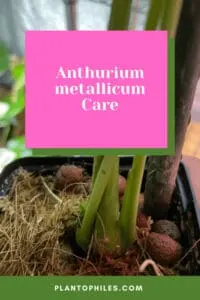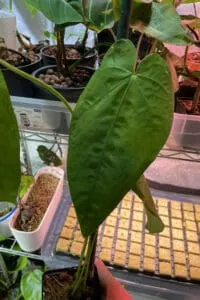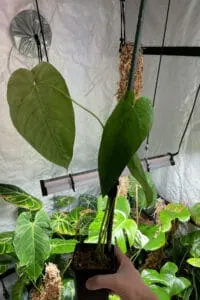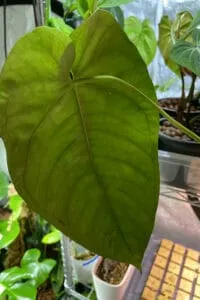Anthurium metallicum is a beautiful aroid.
The leaf blades of the plant are velvety, dark green with very prominent veining.
It belongs to the family Araceae and originated in Colombia.
Somehow both beautiful and bizarre, Anthuriums have a certain undisputed magnetism within them.
For Anthurium metallicum to flourish in our homes, it requires proper care.
(Image Credit, urlocalplantboy IG)
Anthurium metallicum Care
To care for Anthurium metallicum provide a well-draining potting mix using perlite, peat moss, orchid bark, and charcoal as well as bright indirect sunlight. Water your plant moderately once a week and keep the soil slightly moist. Provide a temperature between 60-70°F (15-21 ° C) and humidity above 60%.

Anthurium metallicum Care
Table of Contents
Anthurium metallicum Plant Care
Even though these evergreen, herbaceous perennials only tolerate growing outdoors in frost-free climates, Anthuriums thrive very well in pots as houseplants.
Soil
Anthurium metallicum needs well-draining potting soil. A good mix consists of perlite, peat moss, orchid bark, and charcoal.
Some hybrids can be successfully grown in potting soil with careful watering by cultivating them similarly to Philodendrons, allowing the soil to dry out slightly between waterings.
However, because Anthuriums develop in their native environments in the moss and leaf litter of tree branches, they favor something more akin to an orchid combination.
Typically this is a loose, breathable mix of potting soil, peat moss, bark or mulch bits, charcoal, dirt, pumice or perlite, and sphagnum moss.
Anthurium care can be made a little more manageable by using this form of soil mix.
Water
Anthurium metallicum may only need water once every week or so in winter, while it can require water every few days in summer.
Appropriate watering is vital for the health of an Anthurium metallicum.
During the growth period (March-September), keep the soil lightly moist, letting the top layer merely approach dryness between waterings.
Make it a routine to inspect it at least once or twice a week by digging a finger gently into the soil.
It needs to feel just barely damp. Wait for a little longer if it still feels warm before watering.
Understand that your plant’s watering requirements ultimately depend on your home’s unique light and humidity and can also change significantly with changing seasons and weather.
Also, get to know your plant and its requirements by keeping a close watch on it for the first few weeks after bringing it home.
Light
Anthuriums Metallicium requires medium to bright indirect light to survive in our homes, although they will tolerate less during their dormant time in winter.
They are sensitive to direct light and easily burn, so be careful to shield them from the hot sun rays of the afternoon.
Direct sunlight will burn the leaves and flowers. Low light will slow the growth and produce fewer, smaller flowers.

Anthurium metallicum prefers bright indirect light
Temperature
Anthurium metallicum are comfortable between 65 – 70 degrees Fahrenheit (18.7 to 21 degrees Celsius).
Anthurium metallicum grows in cooler temperatures than most philodendrons and Anthurium as they are growing in high elevations.
They struggle under 55 degrees Fahrenheit (12.7 degrees Celsius) or even die and
In winter, proper care for Anthurium requires keeping a watchful eye and shielding your plants from draughty doors and windows.
It is also necessary for your Anthurium to be protected from forced air.
If Anthurium metallicum is too close to heaters, fans, and air conditioners, it will hurt them.
But they will prosper from subtle air circulation, such as an open window on a warm, humid day.
Humidity
Anthurium metallicum needs high humidity above 60%.
Before taking home an Anthurium, humidity is certainly a consideration to remember and very important for Anthurium care.
In particular, the foliage varieties need elevated moisture to grow and will struggle without it, often having brown edges.
Consider storing your Anthurium Mettallicum in a well-lit bathroom or by your kitchen sink.
You can use a humidifier close to your Anthurium, mist it regularly.
You can also use a plain pebble tray under its pot if putting it in the bathroom or near the kitchen sink is not practical.

Anthurium metallicum needs high humidity above 60%
Fertilizer
Fertilize Anthurium metallicum every 6-8 weeks from March to September.
Anthuriums benefit from fertilization that is normal yet restrained.
An indoor plant formula is sufficient for foliage varieties once every 6-8 weeks from March to September.
Use a well-balanced fertilizer for your Anthurium metallicum to flourish well.
You should avoid feeding your Anthurium metallicum in winters.
Potential salt build-up from fertilizers will harm your plant, so with thorough and deep watering, you can periodically flush the whole root ball.
Repotting
To repot your Anthurium metallicum, prepare a pot that is one size bigger than the existing pot. The width of the new container should, as a general rule, be no larger than an inch or two.
To prevent potting soil from escaping through the opening, cover the drainage opening with a tiny piece of mesh, a paper towel, or a filter paper.
A few hours before repotting, water the Anthurium well; a moist rootball is quicker to repot and also much healthier for the plant.
Try using potting soil that is close to the existing potting mix of the plant. A very thin, loose medium with a pH of around 6.5 is needed for Anthurium.
Using a combination such as two portions of an orchid mix, one portion of peat and one portion of perlite, or equal parts of peat, pine bark, and perlite will help.
Carefully slide the Anthurium out of its current pot. With your thumbs, tease the compacted rootball gently to loosen the roots.
In the pot, put the Anthurium, then fill in with potting soil around the root ball. Through your fingers, gently firm the potting soil.
Consider placing fresh potting soil in the new pot, using just enough to raise the top of the Anthurium’s rootball to around an inch or less below the edge of the pot.
When repotted, the plant must remain at the same soil level it was placed in the initial pot.
Water gently to loosen the soil, and then, if necessary, add a little more potting soil.
Again, it is vital to position the top of the Anthurium’s root ball at around the same level as its old pot. Planting the crown of the plant too deep will cause the plant to rot.

Anthurium metallicum grows in cooler temperatures than most aroids
Pruning
Anthurium trimming should be performed periodically to keep the plant healthy and balanced.
It may cause the stem to bend and result in growth retardation by allowing older growth to linger on the plant.
Look at your Anthurium plant carefully, then start pruning from the top down. Start by removing any leaves that are discolored or dead.
Wilted or dying flowers are cut down to the base of the stem. To boost the appearance of the plant, you can also extract mischievous leaves, but leave at least three to five in place.
Remove the older leaves first, if practicable.
Eliminate the suckers from the Anthurium base; otherwise, they will extract energy from the plant, thus shrinking the size of the flower.
When they are tiny, trim the suckers; trimming large suckers will harm the plant’s base.
Use cutting tools of excellent quality, as rusty blades can rip and destroy stems, making the plant more vulnerable to disease and pests.
Wipe cutting tools between each session. You can use rubbing alcohol or a 10 percent bleach solution to clean and avoid bacterial infection.
Install the plant in a shady area for a few days. Do not worry if the plant looks a little worse in the first few days.
Slight wilting happens when Anthuriums are repotted. Avoid the fertilizer for a few months after repotting the Anthurium to allow the plant time to adjust in its new container.
Propagation
You can propagate your Anthurium metallicum by stem cuttings:
- Locate a developed Anthurium metallicum plant from which you are going to take a cutting. Cut off a length of one stem at least 6 inches long, use pruning shears. Use a stem that has leaves on it in two or three sets.
- Fill a 3/4 full 10-inch diameter clay plant pot with a well-drained potting mixture. Use a pot that has drainage holes at the bottom.
- Make a hole that is 2 to 3 inches deep in the middle of the soil. To make a hole, you can use your finger or another tool, such as the handle of a garden spade.
- Place the cut end of the cutting Anthurium all the way into the cavity and cover the cavity with extra potting soil. When the lower leaves sink into the hole or hit the soil, use your fingertips to take them off.
- Water the soil until saturated. After that, at least every other day, water the soil just do not let the top layer dry out. Typically, Anthuriums grow in rain forests and thus enjoy moist environments.
- Place the cutting in a position that has high humidity and controlled sunlight. Wait before the plant grows its roots, which will take between four to six weeks. You will know that when you begin to see new foliage or the cutting grows taller, roots have grown.
Growth
Anthurium metallicum can grow to a height of 6.6 feet (200cm).
The leaf blades of Anthurium metallicum can get 22-18” long (55-70cm) according to Kew Royal Botanical Garden.
Typically, its leaves are simple, broad, beautifully colored, and are carried on long stalks.
Your plant’s growth greatly depends on the environmental conditions you provide.
Some people do not really have the patience to wait and see their plant grow leaves and get mature.
Common Problems for Anthurium metallicum
Bacterial Blight
The first apparent signs are yellowish (chlorotic) water-soaked clusters along the leaf margins that rapidly develop into dead V-shaped lesions that are the characteristic of this disease.
The diseases affect the plants of the Anthurium by penetrating pores along the leaf margins.
Bacteria can also invade when leaf tissues are torn by pruning, or when insects rupture leaf tissues.
Bacteria can enter through wounds when flowers are harvested.
Bacteria can swim through wet surfaces; it is therefore very essential to keep the foliage dry. The most efficient way to do this is by drip irrigation.
Lower the humidity and temperature by rising air circulation and ventilation around the plant. Allow room on the bench between the plants.
Warm temperatures, high humidity, and saturated soils lead to the production of intestinal droplets.
The infected plants should be discarded as soon as possible.
Rhizoctonia Root Rot
The word “damping-off” is used to explain these typical symptoms. Young, delicate stems are girdled, are saturated in water, and are unable to withstand the burden of the plant.
Rhizoctonia affects the roots and lower stems of the plants, but it can also invade and spread in the upper leaf canopy under wet conditions.
Never introduce tropical soils into content mixes without thermal treatment.
Use well-drained soil mixtures. Avoid storing peat moss, sphagnum moss, chips, or potting media directly on soil surfaces where the fungus can be colonized.
Plants should be planted on raised benches in order to minimize root contact with soil.
Rhizoctonia also has access to plant through contaminated material.
Bacterial Wilt
Leaf yellowing is typically the very first indication to be seen.
The disease spreads quickly across the vascular system of the plant, turning the veins in the leaves and the stems in a brown, bronze color.
Bacterial oozes will be present when the stems of highly infected plants are cut.
Plants will show signs of wilt even though sufficient soil moisture is available.
A comprehensive sanitation program is the most effective way to avoid the spread of this virus and ultimately remove it from the Anthurium plant.
Fungicides containing phosphorous acid have also been shown to reduce infection effectively; however, they do not cure systemically infected plants.
Phytophthora
Phytophthora infections mainly target root systems. Plants can wilt even if sufficient soil moisture is available.
The primary diagnostic technique is root sloughing.
Under extreme conditions, the leaves can have black to brown leaf lesions.
These indications are similar to those produced by Rhizoctonia; but, fungal strands are seldom seen with Phytophthora infections.
Use well-drained, synthetic soil mixtures. Plants with signs of disease should be disposed of, and the remainder of the processing plant should be treated with a fungicide drench.
When potting containers are reused, they should be scrubbed and sterilized.
The cutting of scissors, knives, and tools should be dipped in an effective disinfectant.
The use of fungicides can also help you get rid of the infection.
Tips for Growing Anthurium metallicum
- Place your Anthurium metallicum in bright filtered light to have a healthy plant.
- Never overwater or underwater your plant; just give it the right amount it requires.
- If the plant gets infected by any kind of disease, the very first option for the cure is the use of fungicides.
- The use of fertilizer that is high in phosphorus will help to promote blooms in flowering varieties.
- Install it in a larger pot as your Anthurium grows. Congested roots can stunt the growth of the plant.
- Slow to intermediate growers are Anthuriums. If the environments are to their taste, they can grow faster.
Frequently Asked Questions about Anthurium metallicum Care
What fertilizer is best for Anthurium metallicum?
Anthurium metallicum is best fertilized using a balanced fertilizer. Anthurium plants do not need too much fertilizer to care for them. Your Anthurium plant only needs to be fertilized once every three to four months with a one-quarter intensity fertilizer.
How long will my Anthurium metallicum plant last?
Anthuriums will flourish all year round when properly maintained. You can keep these plants for many years if you provide the right care.
Is Anthurium metallicum a good indoor plant?
Anthuriums are included in NASA’s list of air-purifying species. They are among the best houseplants for indoor air purification. Their big, dark leaves suck up ammonia, formaldehyde, toluene, and xylene, so they are a thoughtful present for a work environment.
Is Anthurium metallicum poisonous?
Every part of the Anthurium plant is poisonous for pets. If it is ingested, it causes mild stomach disorders, and the sap of the Anthurium plant causes skin irritation.
Conclusion About Anthurium metallicum Care
Anthuriums are aroid plants believed to have originated in the Neotropics, where most species in lush, tropical forests grow epiphytically on the branches of trees.
These wild things can be domesticated and make wonderful additions to the home with only a little care.
For anyone who feels like they’ve mastered Philodendrons and most Anthuriums and are looking for a new challenge, an Anthurium metallicum is a great choice.


